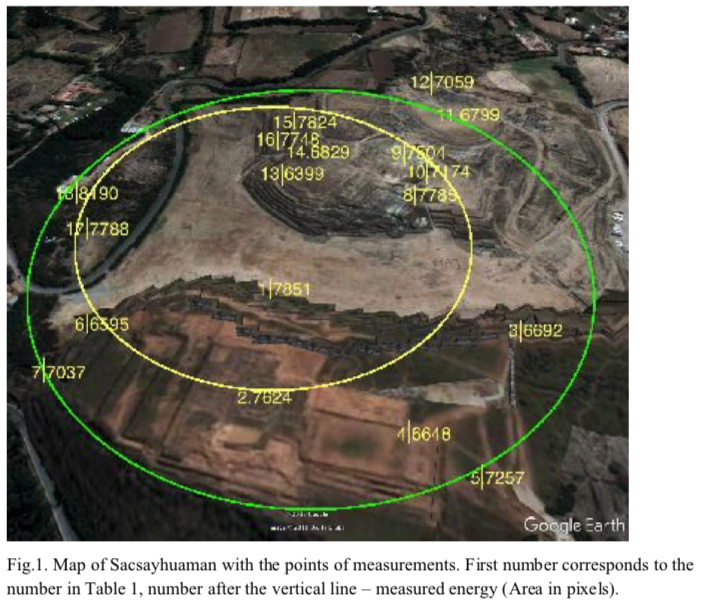Bioelectrography Experiments in Cusco with GDVCAMERA
The Energy of Space
Experiments on ancient objects in Cusco
Korotkov K. G., Galetskii D. V.
In June 2018, we had the opportunity to visit Peru and carry out Bio-Well with Sputnik sensor measurements on a number of ancient sites near Cusco on June 6, 8 and 9.
Every morning device was calibrated in a hotel in Cusco, all measurements were carried out off- line for 10-13 minutes with subsequent processing.
All the values of the parameters measured in the morning and in the evening at the hotel in Cusco, were 50-100% less than the parameters measured at the facilities. Let us consider the data.

Sacsayhuaman
Sacsayhuaman is on a par with Machu Picchu, is the most famous and visited ancient monument in Peru. Historians interpret it as a fortress, and to some extent it could have fulfilled this purpose, but from our point of view, its original function was different. Like other ancient buildings of Peru, it was a sacred religious center, especially from a military point of view, its position is very vulnerable. The surrounding hills exceed it in height, which allows for attackers to fire, remaining invulnerable. The height of the outer wall is not sufficient for defense: it is easy to overcome with short stairs. (However, if we assume that the wall was designed to protect against small-sized creatures, this changes the situation).
We measured for three days and the data correlated well. On different days, the humidity changed from 36 to 33%, the temperature was 19+ / -1 C. during the last measurement it was raining and, in the evening,, it got cold.
Data representation on Google-maps (Fig.1) allows to put forward a certain hypothesis. As can be seen from the figure, we can conditionally distinguish zones that differ in the magnitude of the signal. Note that the measurements were carried out for three days, and all the results were well matched for the presented scheme. Naturally, these results should be considered as preliminary, but they suggest the presence of a geo-active zone in the area with the strongest signal. As we can see, this area embraced the space in front of the fortress, which, as is known from historical evidence, was used for mass ceremonies.
Unfortunately, the lack of time did not allow for additional measurements, so this hypothesis was purely preliminary. At the same time, it allows to outline the direction of further research.
The parameter of Environmental Activity had low values at all measured points (table 1,2), which indicates a favorable energy environment for a person. To understand the value of this parameter, we present graphs of the time dynamics of the parameters at different measurement points (Fig.3). Obviously, the higher the variability of the data, the higher the parameter of the environment activity. Very high values of the activity of the environment is unfavorable for human activity.
Conclusion
This study conducted by leading Russian specialists, convincingly shows that in the construction of Sacsayhuaman was likely used the “clay” technology. Using soft limestone “dough” heated to a high temperature allowed to form the blocks, pouring them with water caused solidification, which allowed to lay on top the following soft block. In this case, the conjugation of three- dimensional surfaces occurs naturally. The same process explains the convex nature of the outer surfaces of the blocks and the presence of protrusions and depressions on them.
Apparently, the construction was carried out during the period of volcanic activity in the “quarry” area when lava flows poured out on the surface. The nature of the rocks in this area fully confirms this fact. So the ancient builders had to look for softened limestones and use this “dough”. Therefore, on the rocks of “quarry” we see some areas with cut holes. This was the area of maximum heating. We do not know when this happened, but it was obvious that it was long before the Inca rule.
This hypothesis explains why other structures with polygonal masonry used much smaller blocks. Apparently, by that time the volcanic activity went down, warming up significantly smaller amounts of limestone.
Another assumption is that ancient civilizations used special furnaces for heating limestone, and later this technology was lost.
The hypothesis of “plasticine stones” was as well used to explain the methods of construction of dolmens constructed from huge stones waiting many tons, which are located on the slopes of the Western Caucasus. No reasonable way exist to explain how multi-ton blocks were transported tens of kilometers up the mountain slopes. Especially when you consider that the builders of the dolmens were at a lower stage of social development in comparison with the Peruvian civilization. If we assume that they used the technology of “plasticine stones”, everything is easily explained. At the same time, it becomes clear why at some point the construction of dolmens completely stopped: there was no more lava capable of warming up limestone.
With all the appeal and credibility of the presented hypothesis, it does not explain how huge blocks of stone were transported during the construction of Oliantaytambo. We were unable to find any plausible explanation. It is obvious that this is a product of a highly developed civilization.
